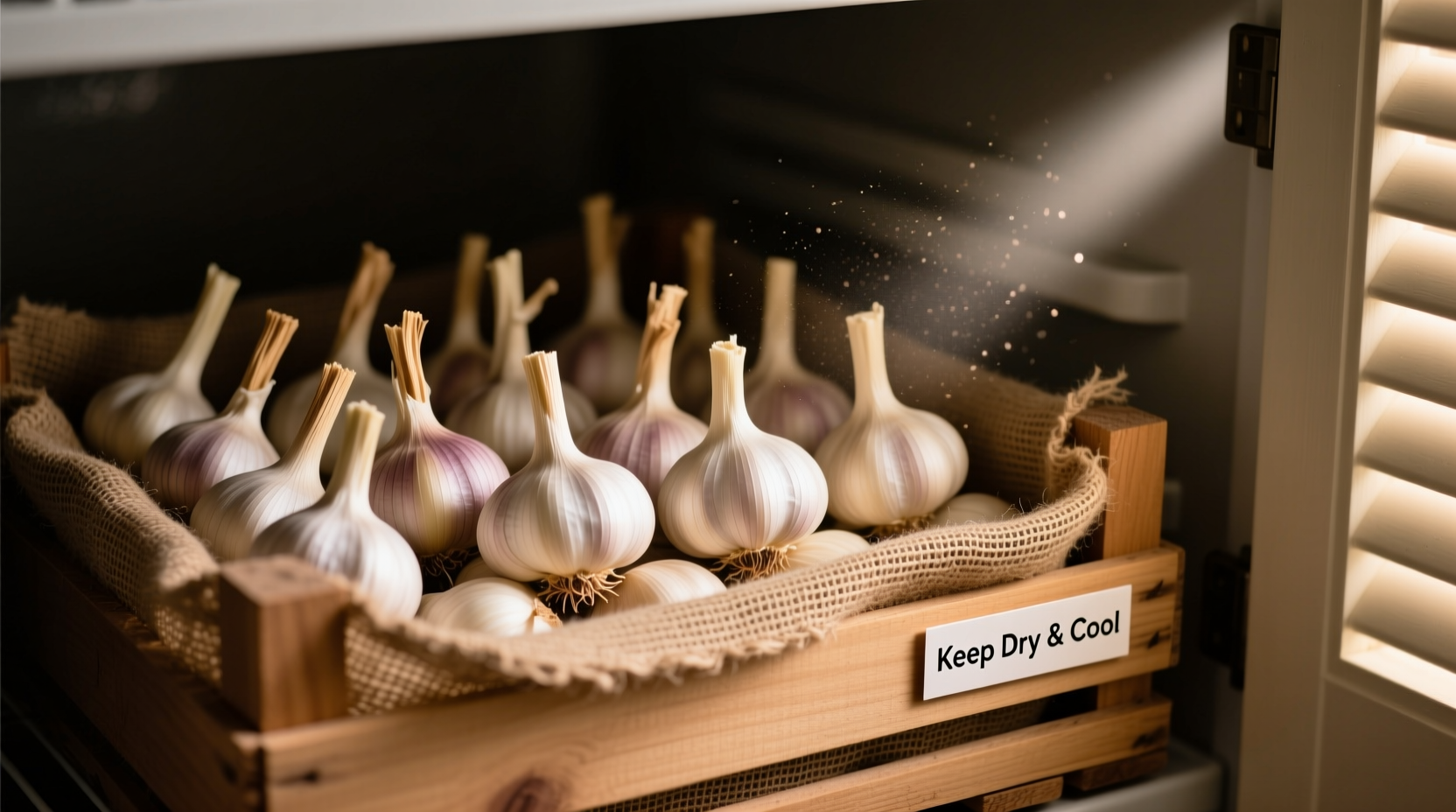The best way to store garlic bulbs is in a cool, dark, dry place with good air circulation at temperatures between 60-65°F (15-18°C) and humidity around 60-70%. Never store garlic in the refrigerator, as the moisture triggers sprouting. Properly stored garlic maintains peak flavor and texture for 3-5 months when using mesh bags, braids, or open baskets that allow airflow.
Garlic transforms ordinary dishes into culinary masterpieces, but nothing ruins the experience like discovering your prized bulbs have sprouted, molded, or turned mushy. After decades of testing storage methods in professional kitchens and home pantries, I've identified the precise conditions that keep garlic at its flavorful best. When you implement these science-backed techniques, you'll extend your garlic's shelf life by up to 75% compared to common storage mistakes most home cooks make.
Why Proper Garlic Storage Matters
Garlic isn't just dormant in your pantry—it's actively respiring, converting stored sugars into energy. The USDA Agricultural Research Service confirms that improper storage accelerates enzymatic reactions that degrade allicin, garlic's key flavor compound. At temperatures above 70°F (21°C), garlic begins preparing for spring growth, triggering sprouting. Excess moisture creates ideal conditions for Penicillium mold, which appears as blue-green spots within days. Understanding these biological processes helps you create the perfect storage environment.
The Step-by-Step Garlic Storage Protocol
Preparing Garlic for Long-Term Storage
Before storing newly harvested or purchased garlic, follow these critical preparation steps:
- Cure harvested garlic for 2-3 weeks in a shaded, well-ventilated area (ideal for home gardeners)
- Gently brush off soil without washing—moisture is garlic's enemy
- Trim roots to ¼ inch but leave protective papery skins intact
- Discard any bulbs with visible damage, cuts, or soft spots
Creating the Ideal Storage Environment
Temperature and humidity control make the difference between garlic that lasts months versus weeks. The Cornell University Cooperative Extension recommends maintaining 60-65°F (15-18°C) with 60-70% relative humidity. This "sweet spot" keeps garlic dormant without triggering metabolic changes. Here's how to achieve it:
- Avoid refrigeration—the 32-40°F (0-4°C) range and high humidity promote sprouting
- Never use plastic bags—they trap moisture and ethylene gas
- Choose breathable containers like mesh bags, woven baskets, or garlic keepers with ventilation holes
- Store away from onions—they emit gases that accelerate each other's spoilage

Storage Method Comparison: What Works and What Doesn't
| Storage Method | Shelf Life | Flavor Preservation | Common Issues |
|---|---|---|---|
| Cool pantry (60-65°F) in mesh bag | 3-5 months | Excellent | None when conditions maintained |
| Refrigerator (crisper drawer) | 2-3 weeks | Poor (sprouting begins) | Mold, premature sprouting |
| Countertop in ceramic keeper | 1-2 months | Good | Drying out in dry climates |
| Plastic bag in pantry | 2-3 weeks | Fair | Mold, yellowing cloves |
Troubleshooting Common Garlic Storage Problems
When Sprouting Begins
If you notice green shoots emerging, don't panic—this doesn't mean the garlic has spoiled. The University of California Food Safety Program explains that sprouted garlic remains safe to eat, though the flavor becomes slightly bitter. Immediately use sprouted cloves in cooked dishes, or separate the sprout (which has a sharp, grassy flavor) for use in sauces. To prevent further sprouting, move garlic to a cooler location immediately.
Handling Minor Mold Issues
Surface mold on garlic skins often occurs in humid environments. The FDA's Food Code states that firm produce with surface mold can be salvaged if properly handled. Carefully peel away affected outer layers, then rub the remaining bulb with a vinegar-water solution (1:3 ratio). Allow to air dry completely before returning to storage. Discard any garlic with soft spots or deep mold penetration.
Seasonal Storage Adjustments
Your storage approach should adapt to seasonal changes in your kitchen environment:
- Summer months: Move garlic to your coolest interior pantry—avoid garages or sheds where temperatures exceed 75°F (24°C)
- Winter heating: Counteract dry indoor air by placing a small bowl of water near storage containers
- Humid climates: Add silica gel packets (food-safe) to absorb excess moisture without direct contact
- Dry climates: Store garlic in loosely woven containers rather than fully open baskets
Remember that hardneck varieties (common in farmers markets) have a shorter shelf life (2-3 months) compared to softneck types (3-5 months). If you've grown your own garlic, hardnecks should be used first in your rotation.
When Garlic Storage Fails: Safety Guidelines
Garlic that has gone bad shows clear warning signs. Discard bulbs that display any of these characteristics:
- Significant softness or mushiness when gently squeezed
- Dark yellow or brown spots between cloves
- Strong, unpleasant odor (fresh garlic has a mild scent)
- Visible mold penetrating beyond outer skins
The National Center for Home Food Preservation emphasizes that spoiled garlic can harbor Clostridium botulinum spores, especially when stored in oil at room temperature. Never attempt to salvage garlic showing multiple signs of spoilage.











 浙公网安备
33010002000092号
浙公网安备
33010002000092号 浙B2-20120091-4
浙B2-20120091-4